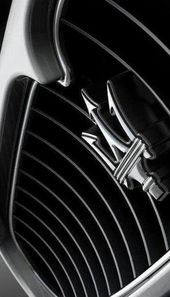.
Maserati Bora
The Maserati Bora is a Maserati two-seater coupe powered by a V8 engine mounted amidships. Produced from 1971 to 1980, it had a top speed of 166 mph (265 km/h).
Shortly after Citroën took a controlling interest in Maserati in 1968, the concept of a mid-engined two-seat supercar was proposed. Lamborghini and De Tomaso already had the Miura and Mangusta whilst Ferrari were known to be developing their own mid-engined contender. Initially known as Tipo 117 and later the Bora, the Maserati project got underway in October 1968 and a prototype was on the road by the summer of 1969. Shown in its final form at the Geneva Salon in March 1971, the first customer cars had been delivered before the end of the year.
A combined steel monocoque chassis and body featured a tubular steel subframe at the back for the engine and transmission. Suspension was independent all round (a first for a Maserati road car) with coil springs, telescopic shocks and anti-roll bars. Citroën's advanced high pressure hydraulics were adopted to operate the ventilated disc brakes, power-assisted rack and pinion steering, the retractable headlights, adjustable steering wheel column, single dry plate clutch and adjustable pedals. Wheels were 7.5 x 15-inch Campagnolo light alloy rims with distinctive removable brushed alloy centres and Pirelli tyres. Engine-wise, Maserati decided to install a subtly uprated version of their familiar DOHC 90° V8, displacement having been 4719 cc thanks to a bore and stroke of 93.9 x 85 mm. Mounted longitudinally, compression was set at 8.5:1 and with four Weber 42 DCNF downdraught carbs and electronic Bosch ignition, the Bora could boast 310 bhp at 6000 rpm. Great attention was paid to reducing noise and vibration, the engine and five-speed ZF transmission being mounted on a subframe attached to the monocoque via four flexible mounts. Additionally, the aluminium engine cover came trimmed in deep-pile carpet and the rear window had double-glazing. The body was created by Giorgetto Giugiaro for Ital Design, fabrication of the all-steel panels being contracted to Officine Padane of Modena
With its uncluttered lines, the Bora was a stunner for sure, but its hefty side profile meant it looked chunkier than the Lamborghini Countach and Ferrari 512BBi. Standing 1138 mm high, perhaps the most distinctive details were the brushed stainless steel roof and windscreen pillars. Inside, the bucket seats, dash, door trim, centre console and rear bulkhead were trimmed in leather, electric windows having been standard, most cars also getting air-con. The steering column was hydraulically tailored for rake and reach, the drivers seat being height adjustable only.
The Bora had a twin, the Merak, which used the same bodyshell and a smaller Maserati V6 engine, also used in the Citroën SM.
Instead, the pedal box could be moved forwards and backwards by around three inches. Weighing in at 1520 kg (around 180 kg heavier than the Ghibli), top speed was 168 mph whilst 0-60 and 0-100 took 6.2 and 13.4 seconds respectively. The first Bora's were delivered to customers in late 1971, only minor production changes being gradually phased in thereafter. These included front lids hinged at the back, pop-up headlights with rounded inside corners, a rectangular front lid-mounted grille and finally, matt black louvres on the sail panels. From 1973, as the 4.7-litre engine hadn't been homologated in North America, Bora's destined for the land of the free were fitted with emissions-equipped 4.9's similar to those found in US-bound Ghibli's. Output was 300 bhp at 6000 rpm, only 10 bhp less than the Euro-spec derivative, however, of more concern were the extremely ugly bumpers that normally had to be added in order to meet US safety legislation. Three years later, a 4.9-litre engine became standard on all Bora's, displacement having been stroked from 85 to 89 mm, this resulting in a 4930 cc. With compression set at 8.75:1, output was 10 bhp up on the 4.7 with 320(330 Europe) bhp at 5500 rpm. Production ran from 1971 to 1978, 524 Bora's eventually being built, 289 of which were 4.7's and the remaining 235, 4.9's.
Maserati struggled after being bought by De Tomaso in 1975, and the Bora was discontinued in 1980.
See also
External links

